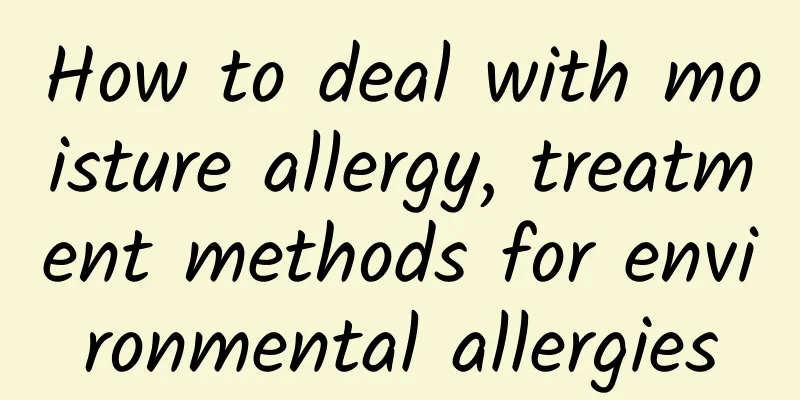How to deal with moisture allergy, treatment methods for environmental allergies

|
We know that when the climate is humid, dust mites and bacteria are easy to breed, and these bacteria often cause allergic reactions in the human body, such as allergic rhinitis, allergic urticaria, etc. In addition to the humid climate, environmental factors such as cold air and air pollution also cause certain harm to the human body. Faced with allergic reactions caused by environmental factors, how should we deal with it? 1: What to do if you are allergic to moisture1: Avoid eating raw and cold food: Raw and cold food will damage our body's yang energy. The principle of dietary regulation is to nourish yang with spicy and warm food, supplemented with many foods that have the function of nourishing yin and moistening dryness, such as pears, oranges, etc. 2: Eat more warm foods: spicy soup and mutton soup are very warm foods. It is very beneficial for patients with cold air allergic rhinitis to eat them regularly. 3: Keep warm to avoid the cold: The temperature is low in winter, so avoid the irritation of the nasal mucosa by cold air. Wear a mask when going out, put on more clothes, focus on "style" rather than "temperature", and keep warm. 4: Take a proper rest and strengthen exercise: Participate in some physical exercise appropriately, and do not be out of breath or sweat profusely during exercise. You can use physical exercises such as cold water baths or cold water face washing to enhance the body's resistance and improve the body's tolerance to cold. In addition, pay attention to a regular work and rest schedule. 2: Environmental factors trigger allergies1: Pollution of the macro-environment has a serious impact on the human respiratory tract, including climate change (including temperature, air humidity and air pressure, etc.), photochemical pollution caused by coal smoke and industrial and automobile exhaust pollution; pollen from harmful plants such as ragweed, mold and spores produced by the decay of domestic garbage, etc. can all induce the onset of allergic asthma and allergic rhinitis. 2: Compared with macro-environmental pollution, micro-environmental pollution is more important for patients with allergic diseases. Common allergens for patients with allergic asthma and allergic rhinitis include indoor dust, dust mite breeding, poor indoor ventilation, fur and feathers shed by pets such as dogs, cats and birds, irritating gases during decoration (paints, coatings and other chemical materials), irritating gases in the kitchen (oil smoke, gas, etc.), cigarette smoke, chemical materials (such as benzene, sulfuric acid, adhesives, formalin and wood dust, etc.), the smell of pesticides, camphor, shoe polish and other odors. For allergic skin diseases, cosmetics, hair dyes and eating certain allergenic or irritating foods (such as seafood, milk, peaches, peppers, mustard, etc.) are important allergens. 3: In addition, climate and seasonal changes (including temperature, air humidity, air pressure and wind direction, etc.) are also closely related to the occurrence of allergic diseases. For example, cold air and humid climate are important causes of asthma, allergic rhinitis and urticaria. The reproduction of dust mites is also closely related to air humidity and temperature. The reason why allergic diseases are prone to occur in spring and autumn is related to the large temperature difference. Certain pollens, dust mites and molds are also very important. From the above phenomena, the relationship between the environment and allergic diseases is very close. It is very important to manage the indoor and outdoor environment for the prevention of allergic diseases. 3. Living in a humid environment every dayPeople with dry skin should pay attention to daily maintenance. They can choose to dry their clothes and bedding at noon to let the sun absorb moisture and kill toxins, thereby maintaining our healthy living conditions. |
<<: What to do if you have an allergic reaction to an IV drip? Treatment measures for drug allergies
>>: What to do if you are allergic to peppers? Several ways to treat allergies
Recommend
What is the cause of neck muscle pain? What should I do?
Symptoms of neck pain often occur in work and lif...
Male genital eczema pictures
Key points: Nowadays, many male friends have expe...
Symptoms and treatment principles of bacterial prostatitis
Prostatitis is not very harmful in life, but it c...
What are the best treatments for epididymitis?
Epididymitis is more common in men and is prone t...
Why can't a man get an erection?
Erectile dysfunction in men may be caused by insu...
What causes thickening of the thyroid ultrasound echo?
Thyroid B-ultrasound examination is a routine exa...
A man's two "grains of rice" are actually crucial
For most men, breasts are just two small "pe...
Treatment for large pores on men's face
Recently, the incidence of male diseases has incr...
Can you hold it in and not cum?
As the level of civilization in today's socie...
Do you know these symptoms of insufficient kidney qi in men?
Kidney deficiency is a common disease that can af...
How to train the middle seam of the chest muscles, push-ups and arm strength machines are the most effective
Many men want to have a body of toned muscles, es...
What should I do if the area under my testicles is itchy and peeling?
Men's testicles are very sensitive and are pr...
How much does a circumcision cost? How much does a circumcision cost?
Many adult male friends have been troubled by the...
Do loaches need to be eviscerated? How should this be done?
In daily life, people often buy and eat loaches, ...
How can boys exercise to improve their sexual function?
Men may not pay attention to how to take care of ...









